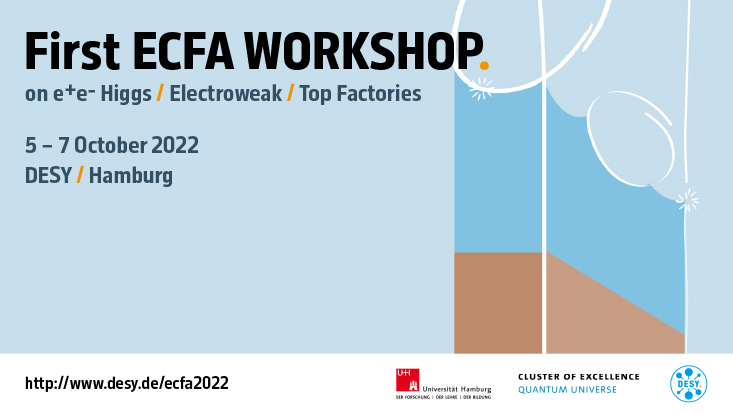First ECFA WorkshopExperts discuss Future Accelerators
5 October 2022

Photo: ECFA/DESY
From 5 to 7 October, the first workshop of the European Committee for Future Accelerators (ECFA) takes places in Hamburg. Hosted jointly by the cluster of excellence Quantum Universe at Universität Hamburg and the research center DESY, the workshop focuses on physics studies with possible future particle accelerators and brings together two hundred experts from all over the world. Particle physicist Elisabetta Gallo gives insights on why the research community discusses future accelerators.
A few months ago, the Large Hadron Collider at CERN started a new period of data taking. The LHC is one of the world’s most powerful particle accelerators. How come the scientific community already thinks about future accelerators?
The Standard Model of particle physics is an extremely successful theory, describing the fundamental components of matter at the tiniest distances, and it is confirmed with high precision in many experiments and now at the LHC. In just ten years after the discovery of the Higgs particle in 2012, we have by now achieved the measurements of so many of its properties with unbelievable precision, confirming even more of the theory. However, we know that the Standard Model is incomplete. For example, it cannot explain dark matter and dark energy revealed in astrophysics and cosmology. As it takes a very long time to design and build an accelerator, we need to start thinking about this well in advance. To give you an idea, the collaborations of the ATLAS and CMS experiments at the LHC that we work on at Universität Hamburg and DESY celebrated their 30th anniversary last week, while first data at the LHC was only taken in 2008. The LHC will run until about 2038, so we are right on time now. We are very proud and honored that the European Committee for Future Accelerators has chosen Hamburg for its first workshop!
The workshop focuses on electron-positron colliders, also called Higgs, Electroweak and Top Factories. What are the advantages of such colliders?
Over the last years, European physicists reached consensus that the next collider should be designed to produce many and easy to study Higgs bosons. There are a few ways to achieve this, and one is an electron-positron collider. As the electron and the positron, its anti-matter partner, are point like objects, these factories provide particularly clean collisions, truly much easier to study than collisions at the LHC. It is not the first time that electron-positron and hadron colliders, like the LHC, will follow each other. With this strategy, the highly successful path of proton-(anti)proton colliders as discovery machines and electron-positron colliders as precision physics instruments continues. The workshop poster shows a profile of Hamburg’s Elbphilharmonie with rings and straight lines, schematically representing circular or linear electron-positron colliders. Both accelerator types are discussed and they offer complementary possibilities for a Higgs factory. Such machines would run at different energies and could both produce millions of Higgs bosons, but also millions of millions of Z bosons, the mediator of the electroweak interaction, or be a factory of top quarks, the heaviest of the quarks composing matter, and therefore the most intriguing one. Future high-precision measurements can clarify the open question about the origin of mass and provide indirect constraints on new theories which are extensions of the Standard Model, answering the main unresolved puzzles in Nature today.
What are the topics of the workshop?
The timescale for a future collider and experiments from first ideas over realization to producing physics results takes decades. We are therefore right on time to start designing optimized detectors for these accelerators and think about what kind of collision signatures these detectors should be able to record. The two things go side by side. We also have a chance now to make sure that sustainability plays a big role in the design. It is amazing to see young researchers motivated to develop detectors and think about smarter machine learning algorithms to improve the performance of these future experiments. The prospects on what we could measure, like the Higgs coupling to strange quarks, were unthinkable up to few years ago. Discussions are also ongoing on how to measure the Higgs coupling to the electron to shed light on why the electron has exactly that mass, giving our Universe its present structure.
Public Talk
To follow the discussion on future accelerators, join the public talk by Hitoshi Murayama (UC Berkeley and IPMU) on 6 Oct, 7:30 pm:
“Does the world need a new collider – and why? The Higgs boson: particle superhero and tour guide to new particles”
The talk will be followed by a round table discussion with the speaker and renowned physicists J. Butterworth (U. College London), F. Canelli (U. of Zurich), F. Gianotti (CERN), B. Heinemann (DESY), K. Jakobs (U. of Freiburg) and J. Thaler (MIT).
Location: DESY Auditorium (Notkestrasse 85, Hamburg) or on DESY's Youtube channel. Questions for the panelists can be submitted through the webinar link.


